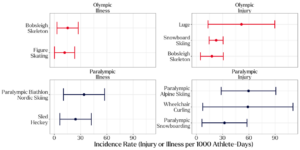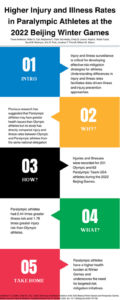Authors: Travis Anderson, Malia G. Cali, Stephanie C. Clark, Ike Hasley, Emily G. Larson, Kayle E. Noble-Taylor, David M. Robinson, Eric G. Post, Jonathan T. Finnoff, William M. Adams
Injury and illness surveillance is critical for the development of effective risk mitigation strategies for athletes. Understanding rates of injury and illness across demographics (e.g., sex, Olympic vs. Paralympic athletes) and where differences may lie permits data-driven approaches to guide prevention. This blog summarizes a recent study examining injury and illness rates in Team USA athletes competing in the the 2022 Beijing Winter Olympic and Paralympic Games (1).
Why is this study important?
Previous research has suggested that Paralympic athletes may face greater health issues than Olympic athletes (2). However, no study has directly compared injury and illness rates between Olympic and Paralympic athletes from the same national delegation. Confirming the extent of these differences between these populations can aid in the development of programs designed to reduce the health burden of athletes whilst also providing evidence to justify medical staffing needs during a Games period. One benefit of analyzing these differences within a single delegation is that errors resulting from differing surveillance methods between countries can be potentially reduced, which may improve the accuracy of the resulting incidence rates.
How did the study go about this?
Injuries and illnesses were recorded for 231 Olympic and 63 Paralympic Team USA athletes who competed in the 2022 Beijing Games. Injury and illness rates per 1000 athlete-days were calculated and compared between Olympic and Paralympic athletes using incidence rate ratios. Rates were also analyzed by sex, sport, anatomic region and body system, and illness type.
What did the study find?
Within this Team USA athlete cohort, Paralympic athletes had 2.44 times greater risk of illness and 1.79 times greater risk of injury than Olympic athletes. We found no differences in injury or illness rates between male and female athletes. Olympic injury rates were greatest in luge, bobsleigh/skeleton, and snowboard/skiing, while Paralympic injury rates were highest in alpine skiing, wheelchair curling, and snowboarding. The highest illness rates for Olympic athletes were found in bobsleigh/skeleton and figure skating and for Paralympic athletes in biathlon/ordic skiing and sled hockey (Figure 1).
Figure 1. Highest Injury and Illness Incidence Rates by Sport.

What are the key take-home points?
This study highlights a greater health burden for Paralympic athletes competing in a Winter Olympic and Paralympic Games and underscores the need for targeted risk mitigation initiatives. Future research should explore whether enhanced athlete physical preparation strategies, modifications to player equipment, or specific sport rule changes have the potential to reduce some of the injury risks factors for Paralympic athletes. Moreover, medical provision for Paralympic athletes should account for a potentially greater health burden during the Winter Paralympic Games.

References
- Anderson T, Cali MG, Clark SC, et al. Team USA injury and illness incidence at the 2022 Beijing Winter Olympic and Paralympic Games. British Journal of Sports Medicine. Published Online First: 27 October 2023. doi: 10.1136/bjsports-2023-107185
- Webborn N, Willick S, Reeser JC. Injuries among disabled athletes during the 2002 winter Paralympic games. Med Sci Sports Exerc 2006;38:811–5.